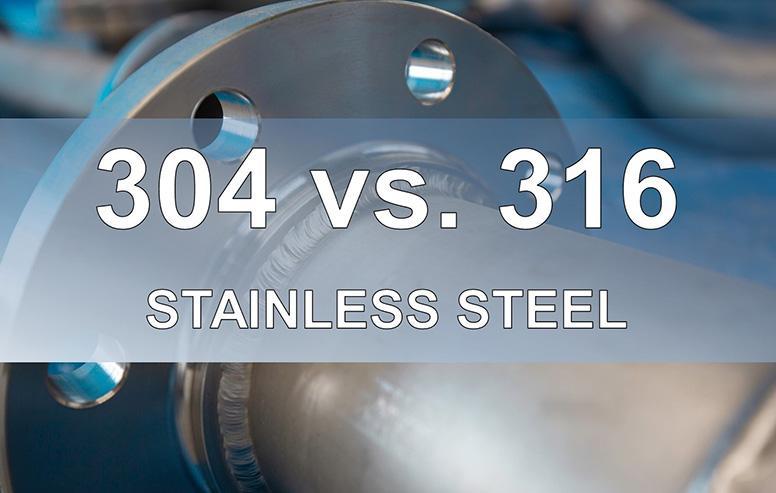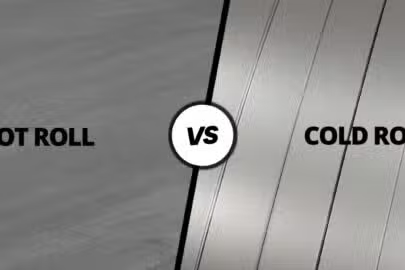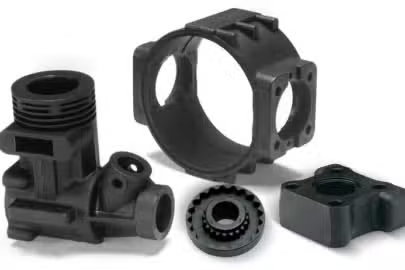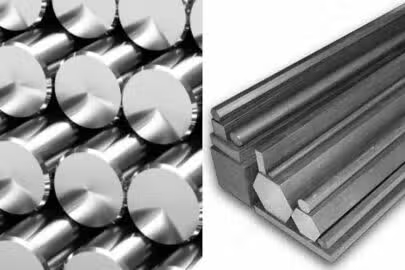Stainless steel stands out as a versatile and durable material used across various industries in metal manufacturing. Among the many grades available, 304 and 316 stainless steel are two of the most popular options. But what’s the difference between 304 and 316 stainless steel and how would you choose one or the other?
That’s what we will discover in the detailed guide below. Here we go through what the stainless steel alloys are, their features, pros, cons, and applications. Then finally we break down the key differentiating factors between the two, that should help you choose one material over the other for your projects. Let’s get going.
What is 304 Stainless Steel?
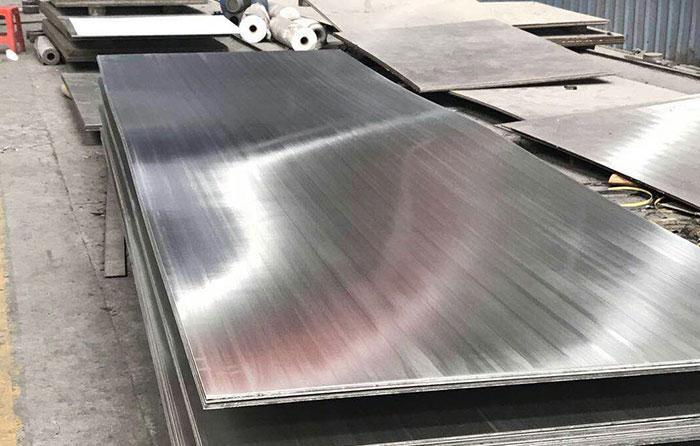
304 stainless steel, often referred to as 18/8 stainless steel, is the most common austenitic stainless steel. Its widespread use stems from its excellent combination of properties and cost-effectiveness.
Features
When you’re considering 304 stainless steel, you’ll find it offers a range of impressive features:
- Composition: 304 stainless steel typically contains 18-20% chromium and 8-10.5% nickel, along with small amounts of carbon (0.08% max), manganese (2% max), silicon (1% max), phosphorus (0.045% max), and sulfur (0.03% max). This composition gives it its characteristic properties.
- Corrosion Resistance: The high chromium content forms a protective layer of chromium oxide on the surface, providing excellent resistance to many corrosive substances. This self-healing “passive layer” reforms if the surface is scratched, ensuring ongoing protection.
- Non-Magnetic Properties: In its annealed state, 304 stainless steel is non-magnetic, which can be crucial for certain applications. However, it may become slightly magnetic when cold-worked.
- Heat Resistance: It maintains its strength at high temperatures, making it suitable for various heat-intensive applications. 304 stainless steel can withstand continuous use at temperatures up to 870°C (1600°F).
- Formability: 304 stainless steel is known for its excellent formability, allowing for easy shaping and fabrication. It can be readily bent, stretched, and deep-drawn without intermediate annealing.
- Weldability: This grade offers excellent weldability by all standard fusion and resistance methods, both with and without filler metals.
- Mechanical Properties: At room temperature, 304 stainless steel typically has a tensile strength of 515-690 MPa, yield strength of 205 MPa, and elongation of 40%. This combination provides good ductility and strength.
Pros
Choosing 304 stainless steel comes with several advantages:
- As one of the most common grades, 304 stainless steel is generally more affordable than other austenitic grades.
- Its popularity means you’ll find it readily available in various forms and from multiple suppliers.
- While not as resistant as some higher-grade alloys, 304 stainless steel still offers impressive protection against many corrosive environments.
- You’ll find that 304 stainless steel provides a favourable balance between strength and weight, making it suitable for a wide range of applications.
- Its smooth surface and corrosion resistance make 304 stainless steel easy to keep clean and hygienic.
Cons
Despite its many advantages, 304 stainless steel does have some limitations:
- In environments with high chloride content, such as coastal areas or swimming pools, 304 stainless steel can be prone to pitting and crevice corrosion.
- Due to its vulnerability to chlorides, you shouldn’t use 304 stainless steel in marine environments without proper protection.
Applications
The versatility of 304 stainless steel makes it suitable for a wide range of applications:
- Food Processing Equipment: Its corrosion resistance and ease of cleaning make it ideal for food preparation surfaces, storage tanks, and utensils.
- Kitchen Appliances: You’ll find 304 stainless steel in many household items like sinks, cookware, and refrigerators.
- Architectural Applications: Its aesthetic appeal and durability make it popular for building facades, handrails, and decorative elements.
- Chemical Containers: 304 stainless steel is often used for storing and transporting various chemicals due to its corrosion resistance.
- Medical Equipment: Its hygienic properties make it suitable for surgical instruments and hospital equipment.
- Heat Exchangers: The material’s heat resistance makes it ideal for use in heat transfer applications.
- Brewing and Winemaking Equipment: 304 stainless steel’s corrosion resistance and ease of cleaning make it perfect for fermentation tanks and other brewing equipment.
What is 316 Stainless Steel?
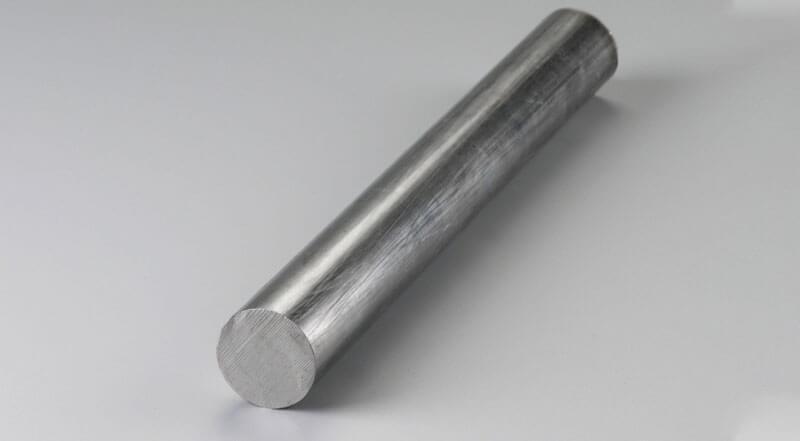
316 stainless steel, often called marine-grade stainless steel, is a higher-grade austenitic stainless steel known for its enhanced corrosion resistance and strength.
Features
When you’re exploring 316 stainless steel, you’ll discover these key features:
- Composition: 316 stainless steel typically contains 16-18% chromium, 10-14% nickel, and 2-3% molybdenum, along with small amounts of carbon, manganese, and silicon.
- Superior Corrosion Resistance: The addition of molybdenum significantly enhances its resistance to various forms of corrosion, particularly in chloride-rich environments.
- Higher Strength at Elevated Temperatures: 316 stainless steel maintains its strength better than 304 at high temperatures. It performs well in temperatures up to 870°C (1600°F), with even better strength retention in the 500-800°C range compared to 304.
- Excellent Formability: Despite its higher strength, 316 stainless steel retains good formability, allowing for various fabrication methods.
- Long-Term Cost-Effectiveness: While initially more expensive, the durability of 316 stainless steel can lead to lower long-term costs in challenging environments.
Pros
Opting for 316 stainless steel offers several advantages:
- The addition of molybdenum provides superior resistance to pitting and crevice corrosion, especially in chloride-rich environments.
- Unlike 304, you can confidently use 316 stainless steel in marine environments due to its resistance to saltwater corrosion.
- When you need a material that maintains its strength in high-heat applications, 316 stainless steel outperforms 304.
- 316 stainless steel offers improved resistance to many industrial chemicals and solvents.
- Its corrosion resistance and ease of cleaning make it ideal for pharmaceutical and semiconductor industries where purity is crucial.
Cons
Despite its superior properties, 316 stainless steel does have some drawbacks:
- The addition of molybdenum and higher nickel content makes 316 stainless steel more expensive than 304.
- You might find that 316 stainless steel is less readily available than 304, potentially leading to longer lead times.
Applications
The superior properties of 316 stainless steel make it suitable for more demanding applications:
- Marine Environments: You’ll find 316 stainless steel used extensively in boat fittings, rigging, and other marine hardware.
- Chemical Processing Equipment: Its resistance to various chemicals makes it ideal for processing equipment in chemical plants.
- Pharmaceutical Manufacturing: The high purity and corrosion resistance of 316 stainless steel make it perfect for drug manufacturing equipment.
- Food Processing in High-Salt Environments: When dealing with high-salt foods or brines, 316 stainless steel is the preferred choice.
- Outdoor Architectural Features: In coastal areas or polluted urban environments, 316 stainless steel is often used for outdoor sculptures, building facades, and signage.
- Pulp and Paper Industry: The material’s resistance to corrosive chemicals used in paper production makes it valuable in this industry.
- Medical Implants: Due to its biocompatibility and corrosion resistance, 316L (a low-carbon variant) is often used for temporary implants and surgical instruments.
- Industrial Exhaust Scrubbers: The corrosion resistance of 316 stainless steel makes it suitable for equipment dealing with corrosive exhaust gasses.
304 vs 316 Stainless Steel: Metal Properties Contrast
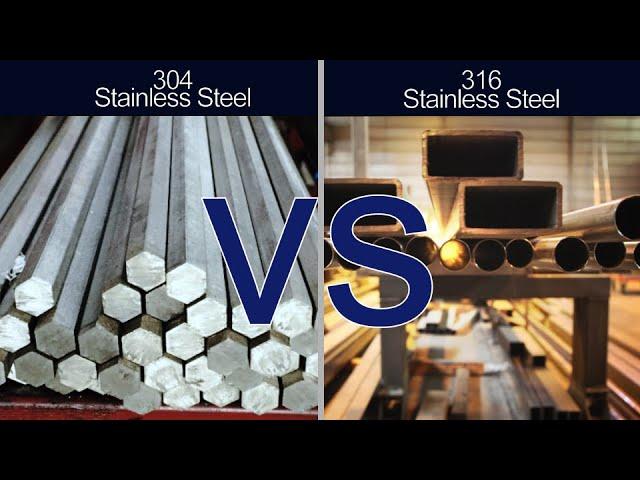
While we’ve explored the individual characteristics of 304 and 316 stainless steel, it’s crucial to understand how these two grades stack up against each other. This comparison will help you make an informed decision based on your specific needs and application requirements.
Composition
The primary difference between 304 and 316 stainless steel lies in their chemical composition:
- 304 Stainless Steel: Contains 18-20% chromium and 8-10.5% nickel.
- 316 Stainless Steel: Contains 16-18% chromium, 10-14% nickel, and 2-3% molybdenum.
The addition of molybdenum in 316 stainless steel is the key factor that sets it apart from 304. This element significantly enhances the corrosion resistance of 316, particularly in chloride-rich environments.
Corrosion Resistance
When it comes to corrosion resistance, 316 stainless steel has a clear advantage:
- 304 Stainless Steel: Offers good overall corrosion resistance and performs well in many environments. However, it’s susceptible to pitting and crevice corrosion in chloride-rich conditions.
- 316 Stainless Steel: Provides superior corrosion resistance, especially against chlorides and other harsh chemicals. It’s significantly more resistant to pitting and crevice corrosion.
If you’re working in marine environments, with salt water, or in chemical processing industries, 316 stainless steel is the better choice. For less demanding applications, 304 stainless steel’s corrosion resistance is often sufficient.
Heat Resistance
Both grades perform well at high temperatures, but there are some differences when it comes to their heat resistance.
- 304 Stainless Steel: Maintains good strength up to about 870°C (1600°F).
- 316 Stainless Steel: Offers slightly better high-temperature strength, particularly in the range of 500-800°C (930-1470°F).
For applications involving prolonged exposure to high temperatures, 316 stainless steel may provide better long-term performance.
Strength
At room temperature, both grades have similar strength properties:
- 304 Stainless Steel: Tensile Strength: 515-690 MPa, Yield Strength: 205 MPa
- 316 Stainless Steel: Tensile Strength: 515-690 MPa, Yield Strength: 205 MPa
However, 316 stainless steel tends to maintain its strength better at elevated temperatures, whereas 304 tends to have minor issues. So, if you want strength across all temperatures, go with 316.
Cost and Availability
There’s a notable difference in cost and availability between the two grades.
- 304 Stainless Steel: More economical and widely available. It’s often the go-to choice for many applications due to its lower cost and ease of procurement.
- 316 Stainless Steel: More expensive due to the addition of molybdenum. It may also be less readily available compared to 304.
When considering cost, remember to factor in the long-term expenses. While 316 stainless steel is more expensive initially, its superior corrosion resistance can lead to lower maintenance and replacement costs over time in harsh environments.
Magnetic Properties
Both grades are austenitic stainless steels, which means they are generally non-magnetic in their annealed state:
- 304 Stainless Steel: Non-magnetic when annealed, but can become slightly magnetic when cold-worked.
- 316 Stainless Steel: Also non-magnetic when annealed, with a lower tendency to become magnetic when cold-worked compared to 304.
Machinability
While both grades can be machined, there are slight differences:
- 304 Stainless Steel: Generally easier to machine due to its lower alloy content.
- 316 Stainless Steel: Slightly more difficult to machine due to its higher alloy content, which can lead to increased tool wear.
Weldability
Both grades offer excellent weldability:
- 304 Stainless Steel: Easy to weld using various methods.
- 316 Stainless Steel: Also easy to weld, but may require more careful control of heat input to prevent hot cracking.
Formability
Both grades offer excellent formability, making them suitable for a wide range of fabrication processes:
- 304 Stainless Steel: Highly formable, making it ideal for complex shapes and deep drawing operations.
- 316 Stainless Steel: Also highly formable, with properties similar to 304.
Applications
The choice between 304 and 316 stainless steel often comes down to the specific application:
- 304 Stainless Steel: Ideal for general-purpose applications in non-corrosive environments. Commonly used in kitchen equipment, appliances, architectural applications, and general industrial equipment.
- 316 Stainless Steel: Best suited for applications involving corrosive environments, especially those with exposure to chlorides. Commonly used in marine environments, chemical processing equipment, laboratory equipment, and medical devices.
Contrast Table
Here’s a quick contrast table to highlight some key technical differences between the two different types of stainless steel alloys.
| Property | 304 Stainless Steel | 316 Stainless Steel |
| Composition | 18-20% Cr, 8-10.5% Ni | 16-18% Cr, 10-14% Ni, 2-3% Mo |
| Corrosion Resistance | Good | Excellent |
| Chloride Resistance | Poor | Good |
| Tensile Strength (MPa) | 515-690 | 515-690 |
| Yield Strength (MPa) | 205 | 205 |
| Hardness (Brinell) | 123-201 | 149-201 |
| Melting Point (°C) | 1400-1450 | 1370-1400 |
| Thermal Conductivity (W/m·K) | 16.2 | 16.3 |
| Electrical Resistivity (μΩ·m) | 0.72 | 0.74 |
| Cost | Lower | Higher |
| Machinability | Good | Slightly more difficult |
| Weldability | Excellent | Excellent |
| Heat Resistance | Good | Better |
| Formability | Excellent | Excellent |
Conclusion
Now that you know what’s the difference between 304 and 316 stainless steel, you can easily decide which one fits your project requirements the best. With the guide we have provided, you can easily figure out a better option between the two in certain differentiating factors such as cost, strength, or heat resistance.
For instance, if you want to save some money, 304 stainless would be a better choice. But if you want better strength at high temperatures 316 stainless steel will suit better. It’s all about your project preferences.
Great, Together
